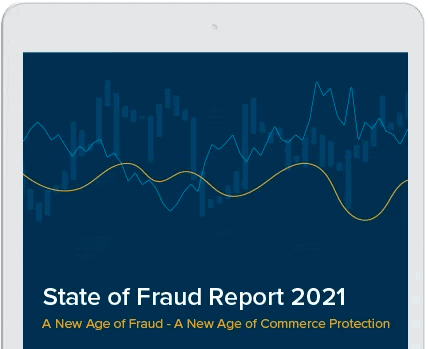Having seen most of what 2021 will offer the world of ecommerce, pundits have turned to the annual ritual of prognosticating what’s to come. But here’s the thing: Predications are so pre-COVID. If ever there were a reason to embrace the mantra “past performance is no guarantee of future results” it’s the disruption the pandemic has injected into online commerce — and everything else.
Signifyd Senior Vice President of Operations & Corporate Development J. Bennet recently sat down with Anne Mezzenga of the Omni Talk “Ask an Expert” podcast to talk about what Signifyd expected to see over the Cyber Five and how those expectations shook out.
The high points: A wave of shoppers new to ecommerce embraced the channel. Pent-up demand among wealthier consumers was released. The biggest retailers paid dearly to meet growth expectations over the long weekend. Not-as-large retailers pulled sales earlier into November and October in order to avoid inventory shortages and fulfillment bottlenecks.

Signifyd’s J. Bennett
Yes, Signifyd saw some of that coming. And, sure, there were a few surprises. Forecasting in the pandemic era comes with a new degree of difficulty.
Industry predictions for the all-important Cyber Five (Thanksgiving through Cyber Monday) we’re somewhat scattered. One payments software provider predicted a 23% boost for online sales year-over-year. eMarketer had ecommerce sales increasing over the long weekend from a low of 11.9% on Saturday to a high of 20.7% on Thanksgiving.
There is the data, and then there’s the context
Now that the dust and the data have settled, we can deliver a solid number: Ecommerce sales for the Cyber Five were up 1% year-over-year.
But, the data devil is always in the details. First, this is definitely a glass-half-full situation. The key point is that online sales were up year-over-year for the Cyber Five. Yes, up — over a historic volume of online sales for Cyber Week 2020. There is reason for retail celebration over the fact that ecommerce outpaced an insane 2020 Cyber Five that was powered by the fear of venturing out and a strong embrace of online shopping.
The ecommerce numbers look even better, given that shoppers were definitely back in brick-and-mortar stores over the long Thanksgiving weekend. In-store shopping over the Cyber Five increased nearly 14%, reaching 104.9 million shoppers, according to the National Retail Federation and Prosper Insights & Analytics. And the increase in online sales also becomes more impressive when you consider that stockouts this season are through the roof — leading to concerns that even those who wanted to buy online would not be able to buy.
So, first, the glass is half full. And second, sometimes our prediction lens is too narrow. Pull back a bit and what you’ll see is that November is the new Cyber Five. There was a time — OK, last year — when the Cyber Five was the nearly mythical barometer of what the overall holiday shopping season would bring.
Out with the Cyber Five; in with the Cyber November
From now on, pundits, prognosticators, analysts, economists and retail leaders will need to look at November — all of it — to get a sense of how the holiday shopping season is starting off and where it’s likely to go. This year, for instance, some of the Cyber Five horsepower was distributed into the earlier days of the month. Retailers worked to pull some Cyber Five spending forward to help manage inventory shortages and delivery bottlenecks caused by ongoing supply chain disruptions.
Consumers, worried about finding the right gift at the right time, were happy to oblige. And they continued to embrace the online shopping option, most likely out of continuing anxiety over shopping in stores for long periods of time paired with a growing appreciation for the convenience of online ordering.
New online shoppers are the key to holiday 2021 success
On “Ask an Expert” Bennett took a more granular look at just what happened during Cyber Week. He noted that the biggest retail enterprises could afford to draw large crowds of online shoppers through pricey digital advertising. That way, they were also able to meet expectations of ever-higher online sales every Cyber Five.
Large, but not huge, retailers and not-so-big retailers didn’t have the luxury of dramatically increasing their spending on digital advertising. Instead, they encouraged consumers to spread out their holiday shopping. In effect, they turned the Cyber Five into Cyber November. The first 20 days of November saw online sales rise 18% over 2020 — a number very much in line with Cyber Five predictions.
So now that the Cyber Five numbers are in, crunched and pointing to what retailers can expect during the rest of the holiday season, what action do they need to take? Signifyd Senior Vice President of Operations & Corporate Development J. Bennett joined Anne Mezzenga on the Omni Talk “Ask An Expert” podcast, where he offered some data-informed strategies.
New online shoppers are arriving in large numbers. Give them a great experience and make them customers for life. Key to success:
- With new customers, make sure you can instantly recognize legitimate orders and fraudulent orders, so as not to slow down the shopping process. And whatever you do, do not decline a legitimate customer based on fear of fraud. Signifyd’s Commerce Protection Platform provides insight into the identity and intent behind every order and builds customer lifetime value by providing a seamless shopping experience.
Be prepared for the holiday spike in order volume and velocity. Key to success:
- This is what you waited all year for. If you’re a retailer of any size, you will not be able to keep up with manual teams. Turn to ecommerce order automation. Signifyd’s solutions scale up infinitely in the face of increasing orders. “One of the largest retailers in the world moved from a team of literally hundreds of human beings to try to keep up with the volume, to using us only to make everything, every single decision, automated,” Bennett said. “When you look at the volume, it’s literally hundreds of cases a second. It’s just staggering how many decisions you have to make. You have to adopt things like machine learning — you have to in order to keep up.”
Accept that you can’t keep up with Amazon. Key to success:
- Control what you can and make it the best customer experience possible, Bennett said. Where you can’t match Amazon step-for-step, communicate with your customers to give them clear expectations. Customers don’t always need same-day or next-day delivery. They just want to know when that delivery will happen. Order automation solutions, like Signifyd, speed up fulfillment and provide certainty.
In a time of scarce inventory, get your goods into the hands of legitimate customers. Key to success:
- Remember 2020’s PlayStation 5 fiasco? We don’t want to remember it either. Bennett says it’s all the more important in a time of disrupted supply chains, when inventory is scarce, to get orders into the hands of legitimate customers who will come back time and again. Signifyd’s Decision Center can detect unauthorized resellers and foil their efforts to corner the market on highly desirable goods that are in short supply. When it comes to highly desirable products, Bennett said successful retailers know, “those have to go to my new customers that are going to come back to me, and not go to some third-party reseller.”
Stores a step down or several steps down from the largest “don’t have the money to compete for Black Friday, Cyber Monday sales,” Bennett explained. They moved those purchases up in the calendar with promotions and smoothed out the curve. Their message, Bennett said: “Hey, buy from us on November 1st. Buy from us on October 15th.”
And among the many things we’ve learned from COVID is that changes in routines, behavior and preferences that were forced to change in the pandemic are not going to completely revert to what they once were.
If you pull the lens back, then, you’ll see that U.S. ecommerce sales were up 13% year-over-year for all of November, according to Pulse data. And that is 13% higher than November 2020 when online sales increased 52% from the previous year.
Global data tells a similar story. November ecommerce sales were up 14% this year after a November 2020 that saw online sales increase 49%, according to Signifyd data.
And while those sales figures are literally the money numbers, there is so much more the data offers when it comes to forecasting the rest of the holiday shopping season.
First, Bennett said on Omni Talk, online retailers are welcoming a large band of shoppers new to ecommerce — or new to regularly buying online. And a significant number of their customers are falling into two distinct groups: Older, wealthy consumers who learned to love ecommerce during the early months of the pandemic and younger, not as wealthy shoppers, who have embraced buy-now-pay-later as a way to afford what they need or want now. And, of course, there are the ecommerce veterans who buy online regularly and may have been customers for years.
Merchants need to be nimble this holiday season
It all means that merchants will need to be incredibly agile throughout the holiday season and beyond in order to hang onto the gains they’ve seen in November.
“I want as many wealthy people, first-time buyers to come to my site, have an excellent experience and then turn them into repeat customers. I want to protect my core market and I have to figure out the younger audience,” Bennett says of retailers’ challenge.
And the early season data also shows that this year the battle in mall and store parking lots won’t be for precious parking spots — the closer-in, the better. Instead it will be for parking spots or traffic lanes marked “curbside pickup.”
Omnichannel sales — order online pick up in-store or at the curb — nearly doubled (up 93%) in November compared to last November when curbside was already the “it” sales channel. That is not going to let up, as December progresses, life gets more hectic and gift-purchasing becomes more urgent.
Nor is it likely to be a passing fad once the holiday season is over or even once the COVID crisis is a memory.
“I think all of the people saying, ‘Oh, it’s just going to be a COVID bump. It’s a COVID bump. It’s a COVID bump. I think we’re past that,” Bennett said on the Omni Talk podcast. “Now most of the folks, even the ecommerce naysayers, have kind of said, “OK, yeah, no, this is a real thing now.”
Fraud pressure will build this holiday season
We can also predict that ecommerce fraud will be with us throughout the holiday season, which is a discouraging no-brainer every year. But to make matters worse, we can predict that fraud pressure will be higher, which means fraudsters will be trying harder in 2021.
Fraud pressure was up 110% in November and it’s likely to increase as the season rolls on. Signifyd has seen fraud pressure ramp up during other “shopping holidays” this year, when the increase in volume allows fraudsters to hide in the “noise” of a busy season and risk teams are on the brink of being overwhelmed by volume and velocity.
During the week of Mexico’s Buen Fin shopping holiday, for instance, Signifyd saw fraud pressure rise 394% from a year ago. (Signifyd monitors fraud pressure by tracking the rise and fall of very risky orders on its Commerce Network.)
On top of fraud, Signifyd also tracked a 43% increase year-over-year in consumer abuse — for instance, cases in which a customer falsely claims that an ordered package never arrived or falsely claims an order arrived in damaged or unsatisfactory condition.
Along with the extra peril, however, comes greater opportunity for retailers. Throughout November, several key verticals registered strong increases in average order value. Some of that can no doubt be attributed to higher inflation compared to a year ago. But a significant portion is due to customers buying more or more expensive items — or both. Electronics, for instance, saw basket sizes up 33% in November over last year and Sporting Goods saw a 14% boost.
Electronics was a standout for November in another category as well: Sales in the vertical were up 31% over a year ago. So yes, expect more good things from electronics this holiday season.
All the indications point in that direction, so how could we possibly be wrong? Please, don’t answer that.
Feature photo by Getty Images
Looking for more insights into Cyber Five performance and what it means to the holiday season ahead? Check out Signify’s J. Bennett on the Omni Talk “Ask an Expert” podcast.











